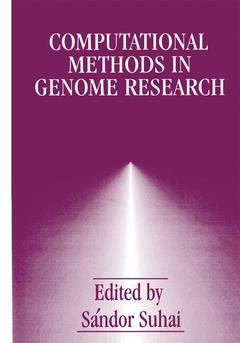Description
Computational Methods in Genome Research, Softcover reprint of the original 1st ed. 1994
Coordinator: Suhai Sándor
Language: English
Subjects for Computational Methods in Genome Research:
Keywords
Chromosom; DNA; chromosome; databases; development; evolution; genetics; genome mapping; polymer; protein; proteins
Publication date: 10-2012
227 p. · 17.8x25.4 cm · Paperback
227 p. · 17.8x25.4 cm · Paperback
Description
/li>Contents
/li>
The application of computational methods to solve scientific and pratical problems in genome research created a new interdisciplinary area that transcends boundaries traditionally separating genetics, biology, mathematics, physics, and computer science. Computers have been, of course, intensively used for many year~ in the field of life sciences, even before genome research started, to store and analyze DNA or proteins sequences, to explore and model the three-dimensional structure, the dynamics and the function of biopolymers, to compute genetic linkage or evolutionary processes etc. The rapid development of new molecular and genetic technologies, combined with ambitious goals to explore the structure and function of genomes of higher organisms, has generated, however, not only a huge and burgeoning body of data but also a new class of scientific questions. The nature and complexity of these questions will require, beyond establishing a new kind of alliance between experimental and theoretical disciplines, also the development of new generations both in computer software and hardware technologies, respectively. New theoretical procedures, combined with powerful computational facilities, will substantially extend the horizon of problems that genome research can ·attack with success. Many of us still feel that computational models rationalizing experimental findings in genome research fulfil their promises more slowly than desired. There also is an uncertainity concerning the real position of a 'theoretical genome research' in the network of established disciplines integrating their efforts in this field.
Can Computational Science Keep Up with Evolving Technology for Genome Mapping and Sequencing? (C.R. Cantor). Informatics and Experiments for the Human Genome Project (H. Lehrach et al.). Date Management Tools for Scientific Applications (V.M. Markowitz). The ACEDB Genome Database (R. Durbin, UJ. ThierryMieg). The Integrated Genomic Database (O. Ritter). Genetic Mapping (J. Beckmann). Representing Genomic Maps in a Relational Database (R.J. Robbins). Livermore's Pragmatic Approach to Integrated Mapping for Chromosome 19 (T. Slezak et al.). Searching Protein Sequence Databases (W.R. Pearson). Algorithmic Advances for Searching Biosequence Databases (E.W. Myers). Pattern Recognition in Genomic and Protein Sequences (J.G. Reich). New Algorithms for the Computation of Evolutionary Phylogenetic Trees (G.H. Gonnet). Modelling Protein Structure from Remote Sequence Similarity (W.R. Taylor). Genetic Algorithms in Protein Structure Prediction (F. Herrmann, S. Suhai). Statistical Models of Chromosome Evolution (M.J. Bishop). Deciphering the Genetic Message (C. Frontali). Index.
© 2024 LAVOISIER S.A.S.




